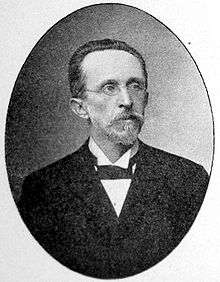Ivan Borgman
| Ivan Ivanovich Borgman | |
|---|---|
 | |
| Born | 24 February 1849[1] |
| Died | 17 May 1914 (aged 65)[1] |
| Nationality | Russian |
| Fields | Physics |
| Institutions | Saint Petersburg State University |
Ivan Ivanovich Borgman (24 February 1849- 17 May 1914)[2] was a Russian physicist who first demonstrated in 1897 that X-rays and radioactive materials induced thermoluminescence.[3]
Biography
Borgman was born to a Russified Finnish-born father and a Russian mother. He entered the Physics and Mathematics department of Saint Petersburg State University, in 1866 and graduated in 1870. In 1873, Borgman went to the University of Heidelberg,[4] where he attended lectures and studied in the laboratory under the German physicist Gustav Kirchhoff. In 1875 he was appointed as a laboratory assistant at St. Petersburg University. Borgman received his Doctorate in 1882 after defending his thesis "On Slight heating of iron in the magnetization."
He became a professor of physics in Saint Petersburg State University from 1888. There he taught the famous physicist Alexander Popov. He along with Orest Khvolson taught one of the earliest course of electrical engineering in Russia.[2] In 1897, Borgman became the first scientist to demonstrate that X-rays and radioactive materials induce thermoluminescence.[3] He was also the first elected rector of the Saint Petersburg State University in 1905. He left the post in 1910.[1]
Under the leadership of Borgman, the V. A. Fock Institute of Physics was created in 1901. He was the second director of the institute from March 1902 to 1914 after F. F. Petrushevsky.[5]
Awards
In 1899, the Saint Petersburg State Electrotechnical University awarded Borgman the title of Honorary electrical engineer. In 1913 he was awarded honorary degree of Doctor of Laws (LLD) by University of St Andrews in Scotland.[6]
References
- 1 2 3 "Borgman, Ivan Ivanovich". The Great Soviet Encyclopedia. Retrieved 12 June 2013.
- 1 2 Radovsky, M. (1 January 2001). Alexander Popov: Inventor of Radio. The Minerva Group, Inc. p. 14. ISBN 978-0-89875-307-3. Retrieved 12 June 2013.
- 1 2 Terrence Ryan, Michael; Poston, Sr., John W. (March 2006). A Half Century of Health Physics: 50th Anniversary of the Health Physics Society. Lippincott Williams & Wilkins. p. 114. ISBN 978-0-7817-6934-1. Retrieved 12 June 2013.
- ↑ "Russian Scientists in Heidelberg". guideheidelberg.de. Retrieved 12 June 2013.
- ↑ "V. A. Fock Institute of Physics". V. A. Fock Institute of Physics. Retrieved 12 June 2013.
- ↑ "Honorary Degrees at the University of St. Andrews". Science , New Series. American Association for the Advancement of Science. 34 (873): 374–375. Sep 22, 1911. doi:10.1126/science.34.873.374. JSTOR 1638189.